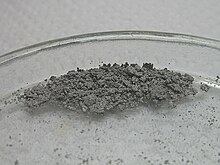Silver acetylide is an inorganic chemical compound with the formula Ag2C2, a metal acetylide. The compound can be regarded as a silver salt of the weak acid, acetylene. The salt's anion consists of two carbon atoms linked by a triple bond, thus, its structure is [Ag+]2[−C≡C−]. The alternate name "silver carbide" is rarely used, although the analogous calcium compound CaC2 is called calcium carbide. Silver acetylide is a primary explosive.

| |
| Names | |
|---|---|
| Preferred IUPAC name
Silver acetylide | |
| Systematic IUPAC name
Silver(I) ethynediide | |
Other names
| |
| Identifiers | |
3D model (JSmol)
|
|
CompTox Dashboard (EPA)
|
|
| |
| |
| Properties | |
| Ag2C2 | |
| Molar mass | 239.758 g·mol−1 |
| Appearance | gray or white solid |
| Density | 4.47 g/cm3[1] |
| Melting point | 120 °C (248 °F; 393 K) |
| Boiling point | decomposes |
| insoluble | |
| Hazards | |
| Occupational safety and health (OHS/OSH): | |
Main hazards
|
highly sensitive primary explosive |
| NFPA 704 (fire diamond) | |
| Flash point | 77 °C (171 °F; 350 K) |
| Thermochemistry | |
Std enthalpy of
formation (ΔfH⦵298) |
357.6±5.0 kJ/mol[2] |
Except where otherwise noted, data are given for materials in their standard state (at 25 °C [77 °F], 100 kPa).
| |
Synthesis
editSilver acetylide can be produced by passing acetylene gas through a solution of silver nitrate:[3]
- 2 AgNO3(aq) + C2H2(g) → Ag2C2(s) + 2 HNO3(aq)
The reaction product is a greyish to white precipitate. This is the same synthesis from Berthelot in which he first found silver acetylide in 1866.[4]
The double salt is formed in acidic or neutral silver nitrate solutions. Performing the synthesis in basic ammonia solution does not allow the double salt to form, producing pure silver acetylide. To properly form the double salt, acetylene gas is passed through dilute silver nitrate and nitric acid solution. Instead of the conventional synthesis of passing acetylene gas through silver nitrate solution, a purer and whiter precipitate can be formed by passing acetylene gas through acetone and adding the acetylene solution drop-wise to a dilute silver nitrate and nitric acid solution. The reaction was performed at ambient room temperature.
Silver acetylide can be formed on the surface of silver or high-silver alloys, e.g. in pipes used for transport of acetylene, if silver brazing was used in their joints.
Explosive character
editPure silver acetylide is a heat- and shock-sensitive primary explosive. Silver acetylide decomposes through the reaction:
- Ag2C2(s) → 2 Ag(s) + 2 C(s)
The detonation velocity of the silver acetylide-silver nitrate double salt is 1980 m/s, while that of pure silver acetylide is 1200 m/s.[5]
Solubility
editSilver acetylide is not soluble in water and is not appreciably soluble in any other solvent.
References
edit- ^ McCowan, J. D. (1963). "Decomposition of silver acetylide". Transactions of the Faraday Society. 59: 1860–1864. doi:10.1039/tf9635901860.
- ^ Finch, Arthur; Gardner, Peter J.; Head, Arthur J.; Majdi, Hassan S. (1991). "The standard enthalpy of formation of silver acetylide". Thermochimica Acta. 180: 325–330. doi:10.1016/0040-6031(91)80402-5.
- ^ G.-C. Guo; Q.-G. Wang; G.-D. Zhou; T. C. W. Mak (1998). "Synthesis and characterization of Ag2C2·2AgClO4·2H2O: a novel layer-type structure with the acetylide dianion functioning in a 6-η1,η1:η2,η2:η2,η2 bonding mode inside an octahedral silver cage". Chem. Commun. (3): 339–340. doi:10.1039/a708439k.
- ^ M. P. Berthelot (1866). "Ueber eine neue Klasse zusammengesetzter metallhaltiger Radicale (A new class of combined metallic radicals)". Annalen der Chemie. 138 (2): 245–253. doi:10.1002/jlac.18661380215.
- ^ Matyáš, Robert; Pachman, Jiří (2013). Primary Explosives. Berlin, Heidelberg: Springer Berlin Heidelberg. doi:10.1007/978-3-642-28436-6. ISBN 9783642284359. S2CID 199492549.
